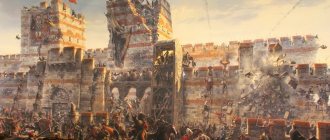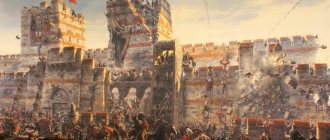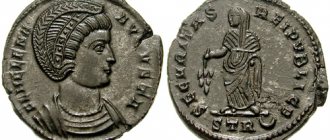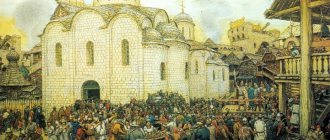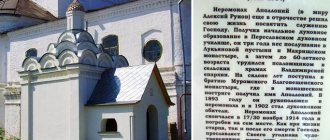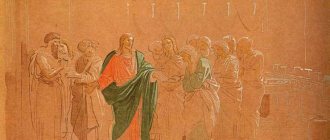Emperors of the Byzantine Empire before its conquest by the Crusaders
Constantine I the Great (306-337) Licinius (308-324) Constantius I (337-350) Constantius II (337-361) Julian II the Apostate (361-363) Jovian (363-364) Procopius (usurper, ruled ca. 365 ) Valens II (364-378) Theodosius I the Great (379-395) Arcadius (395-408) Theodosius II the Younger (408-450) Marcian (450-457) Leo I Maccellus the Thracian (457-474) Leo II (474) Zenon (474-491,475-476 - outside KPlya) Basilisk (475-476) Anastasius I Dicor (491-518) Justin I (518-527) Justinian I the Great (527-565) Theodora I (527-548) Justin II ( 565-578) Tiberius II (574-582) Mauritius (582-602) Phocas (602-610) Heraclius I (610-641) Constantine III (641) Herakleion (Heraclius II) (641) Constans II (641-668) Constantine IV Pogonatus (668-685) Justinian II Rhinotmet (685-695 and 705-711) Leontius (695-698) Tiberius III (Apsimar) (698-705) Fnlippic (Vardan) (711-713) Anastasius II (Artemius) (713-716) Theodosius III (715-717) Leo III Isaurian or Syrian (717-741) Constantine V Copronymus or Cavallinus (741-775, 742-743 - outside KPlya) Artavasdes (742-743) Leo IV Khazar (775 -780) Irina (780-790 and 797-802) Constantine VI Porphyrogenitus (790-797) Nikephoros I Genik (802-811) Stavraki (811) Michael I Rangave (811-813) Leo V the Armenian (813-820) Michael II Travl (820-829) Theophilus (829-842) Theodora (II) (842-856) Michael III Drunkard (856-867) Basil I the Macedonian (867-886) Leo VI Philosopher (886-912) Alexander (912- 913) Zoe I Karvonopsina (914-919) Roman I Lekapin (919-944 Dec. 16) Constantine VII Porphyrogenet (independent. from 27 Jan. 945 - +959 November) Romanus II (959- +963 March 15) Theophano (963) Nikephoros II Phocas (963-969) John I Tzimisces (969-976) Basil II Bulgarokton (976-1025) Constantine VIII (1025 -1028 ) Roman III Argyrus (1028 -1034) Michael IV Paphlagon (1034-1041) Michael V Calafates (1041 -1042) Zoe II Porphyrogenita (1042) Constantine IX Monomachus (1042-1055) Theodora (III) Porphyrogenita (1042 and 1055 -1056 ) Michael VI Stratioticus (1056-1057) Isaac I Komnenos (1057 -1059) Constantine X Ducas (1059 -1067) Eudokia Makremvolitis (1067 and 1071) Romanus IV Diogenes (1068 -1071) Michael VII Ducas Parapinac (1071 -1078) Niknfor III Botaniates (1078-1081) Alexios I Komnenos (1081 -1118) John II Komnenos (1118 -1143) Manuel I Komnenos (1143 -1180) Alexios II Komnenos (1180-1183) Andronicus I Komnenos (1183 -1185) Isaac II Angel (1185 -1195 and 1203-1204) Alexius III Angel (1195 -1203) Alexius IV Angel (1203 -1204) Alexius V Ducas Murfuzl (1204) Constantine XI Lascaris (1204-1205)
BYZANTOLOGIST
“God commands us to love everyone, but we drove out love, and it fled from the earth. You will not find perfect love according to God on earth. Love is banished by all, hated by all. And envy reigns."
Venerable Ephraim the Syrian[1]
“I reasoned with myself that I am wiser than this person, because we both probably know nothing, but he, not knowing, imagines that he knows something, and if I don’t know, then and I don’t imagine.”
Socrates[2]
“Whoever thinks that he knows something does not yet know anything as he should know. But whoever loves God has been given knowledge of Him.”
(1 Cor.8:1-3)
I.
When suddenly plans collapse in the blink of an eye without any seemingly visible reasons, and the unknown awaits ahead, abundantly saturated with our own assumptions about the future of the darkest kind, who has not experienced an all-consuming feeling of panic and fear?! Who retained self-control at a moment when the shock of dashed hopes led to paralysis of the will, fettering our actions and consciousness?! Who has not fallen into despair from loneliness - the inevitable companion of any failure?! Meanwhile, these sensations are a natural consequence of the spiritual state in which we usually find ourselves.
Of course, in earlier times man did not suffer from a lack of pride, but today we have almost “made a name for ourselves” (Gen. 11:4), as the builders of the Tower of Babel once dreamed of. Let's be honest, never before has self-confidence been so firmly rooted in a person as in our days of total and widespread de-Christianization of society. If there is one thing that “modern man” has firmly grasped, it is that he is the highest creation of the universe.
Concentrating on himself (and in himself), man got used to doing without God, because this destructive conviction about his own exclusivity was not born out of nowhere and not yesterday, although it did not immediately take on modern, filigree-honed features. The founders of secular “anthropocentric” philosophy have long sought evidence of man’s dominance over the outside world, including, strange as it may seem, in the Bible.
Indeed, the Holy Scriptures contain numerous facts confirming that man was created by the master of the world, the co-creator of God, and is His image and likeness.
Even Angels do not possess this property, and, despite the incomparability of their and human abilities, it is not they who will judge people, but people – the Angels (1 Cor. 6:3); even if only fallen spirits, whom the Lord “is keeping in everlasting chains under darkness for the judgment of the great day” (Jude 6). Moreover, the saints will judge the world (1 Cor. 6:2). In other words, under certain circumstances, a person becomes the measure of things, events and actions. And the categorical nature of his assessment is such that it is final in nature - after all, we are talking about the Last Judgment of Christ, where the saints are also destined for the place of judges[3]. Continue reading →
Emperors after the restoration of the Byzantine Empire
Michael VIII Palaiologos (1261-1282) Andronikos II Palaiologos the Elder (1282 -1328) Michael IX Palaiologos (1295-1320) Andronikos III Palaiologos the Younger (1325-1341) John V Palaiologos (1341 -1391, with breaks in 1376 -1379 and 1390 ) John VI Cantacuzene (1341-1354) Matthew Cantacuzene (1353 -1357, from 1354 - outside the CP) Andronikos IV Palaiologos (1376-1379) John VII Palaiologos (1390, regent in 1399 -1403) Manuel II Palaiologos (1391-1425) John VIII Palaiologos (1425-1448) Constantine XII Palaiologos Dragash (1448-29 May 1453)
Applications
Quoted from the publication: S.B. Dashkov. Emperors of Byzantium. M.: Publishing house "Red Square", "APS-books", 1996.
It is impossible to explain all the concepts of the Byzantine world in one glossary. For comparison, the interested reader can use [246] (see section Bibliography), as well as glossaries compiled by Ya.N. Lyubarsky [53 and 69], A.A. Chekalova [70, new ed.] and the authors [4]
.
Augustal (Prefect Augustal)
- governor (prefect) of Egypt from the 4th century. In the Byzantine era there were two A. - Upper and Lower Egypt.
Autokrator
- autocrat.
Agridius
– a farm separated from the community; in the XIII–XV centuries. - a settlement dependent on the landowner.
Adscriptition (enapograf)
– assigned
column,
Akakia
- part of the imperial ceremonial vestments - a bag of ashes, which the emperor carried in his hand as a reminder of the frailty of all earthly things.
Akrites
– landowners who received land and the right to tax benefits in exchange for obligations to protect borders.
Acrostic
– the total amount of taxes from a given tax unit; written in a row in the margins of the scribe's book.
Akrivia canons
– the opposite
of economy
of Byzantine church law; expressed in the recognition that church canons are higher than secular laws.
Actimones (capnicaria)
- tax category of poor peasants.
Akufy
– weapon: a long and thin sword, shaped like a heron’s beak; intended to pierce the chain mail armor common in the East.
Allilengy
- “mutual responsibility”, the payment of taxes by the community for its poor members (or
dinata
- for their dependent people).
Aloniatikon
- “grooming tax”, a monetary duty in favor of the landowner in late Byzantium.
Pulpit
- in the early Christian church - elevation for the readers of St.
Scripture and the preacher. At first it was located in the middle of the temple, from the 15th century. - in the north. Currently, A. is a protrusion of the sole,
extended into the center of the temple.
Anagraphevs
- a position in many ways similar to the position
of epopt.
Anchorite
- hermit, desert dweller (monk).
Angaria
– conscription; initially - the supply of oxen for state mail, officials, ambassadors; later - mainly arable working in favor of the landowner.
Anepignost
- see
xenopar.
Annona
– 1) supply of food from Egypt to Rome and Constantinople; 2) providing food (money) to the troops and apparatus of the province.
Antikanfar
- type of tax.
Anfipat
– title higher than
patrician;
corresponded to the Roman
consul.
Apocrisiary
- Ambassador
Apor
- poor man.
Argirovul
- a letter of honor, sealed with a silver seal.
It was given by the emperor, more often by the despot.
Argyroprate
- jeweler A. were also called money changers and moneylenders.
Arnane
- followers of the Alexandrian presbyter Arius (? - 336), in contrast to the Orthodox Church, who taught that God the Son was born, could not exist before his birth and, therefore, had a beginning and is not equal to God the Father. Beginning with Arius, this teaching acquired many directions - to the point that some Arians considered the Son not one of the hypostases of the Trinity, but only the “excellent creation” of the Father, not consubstantial with him (omoophbios; in the orthodox interpretation), but similar in essence (omoiophbios;) , similar (omoios) etc. Arianism was condemned at the Council of Nicaea in 325, but subsequently prevailed in the Church of the East, especially under the emperor. Constantius II and Valens II. In 381, Arianism was finally recognized as a heresy. The Christ of some Arians is not God, but a hero; this point of view was understandable and close to the barbarian peoples of the empire, and many (Vandals, Goths, partly Franks, etc.) accepted Christianity as presented by the followers of Arius.
Ariston
– first meal of the day (breakfast).
Arithm
– “numbers”, one of
the tagmas.
Archon
- “chief”, a concept often used by Byzantine historians in the broadest sense in relation to their own and foreign officials, rulers, etc.
Asikrit
- secretary.
Aspron trachi (aspr, trachi)
– 1) low-grade small change coins of unknown denomination (from 1/48 to 1/184
yperpiron).
They were minted by all the emperors after Alexei I from silver with a large amount of ligature (with a silver content of less than 50% percent, such an alloy is called billon). 2) coins from electrum (an alloy of gold with a large amount of silver) in 1/3 of
the nomisma-hyperpiron
(after the reform of 1092
Nomisms
of the period 1040–1080s also fall under the definition of A. (1) and (2). During the time of the last Palaiologans, trachea contained an insignificant amount of silver (ligature, mainly copper, tin, lead - up to 95%) and had a dark color.
Aphesia
– type of tax.
Aerikon
– type of tax.
Band
- a cavalry unit led by
committee
B. At different times, the number of B. fluctuated from several tens to several hundred people.
Baptidio
– Master’s insignia
:
a decorated baldric on both shoulders.
Besant (Byzantine)
- this is how eastern gold coins were called in Europe, initially Byzantine, then Arab, etc. From the custom of the Crusaders to decorate the shield around the perimeter with these coins brought from the Holy Land, the second meaning is a heraldic sign: a gold (silver) circle on the coat of arms.
Bogomils
- one of the most widespread heresies in the 13th century, mainly in Bulgaria;
ideologically close to the Albigensians and Cathars. Wed. peacocks.
Bucellaria (Vucellaria)
– 1) in early Byzantium – the personal squad of a private individual, usually a commander;
2) the name of one of the themes.
Basileus
- Emperor.
Vasilisa
- Empress.
Vasilikon
– silver coin of the Palaiologos;
in weight and silver content it is close to miliaria.
Veneti
- see
Dima.
Vestiary
– 1) an official in charge of the imperial wardrobe and special treasury; protovestiary - senior V., high position; 2) the actual treasury of the emperor.
West, Westarch
– high titles, the meaning of which changed in the X-XII centuries.
Vestioprate
– dealer in silk and other expensive clothes.
Vicar
– 1) vicar
of the diocese;
2) officer rank in the infantry; 3) a person who replaced the highest church hierarch.
Vindik
- governor of the government in the cities of the late Roman Empire.
Lord
- representative of the landowning nobility,
Dinat.
Voidat
- a taxable category of peasants who had a plot of land that could be cultivated with the help of one ox.
Hexagram
- heavy (2
miliaria)
silver coin, minted in gray. VII century
Genikon
- financial department.
Gynoecium
– women’s half of the house, women’s workshop.
Histamenone
– see
nomisma.
Dean
– 1) in the Roman army - the commander of a dozen; 2) gatekeeper.
Decarchy
- ten, a small detachment of the Byzantine army.
Decurion
– see
curials.
Despot
– “lord”, a high title;
in late Byzantium - the governor of the despotism,
usually the closest relative of the emperor.
Despotia (despotate)
- in late Byzantium, a region that was under the rule
of a despot
and relatively independent of the Emperor of Constantinople (D. Morea, Thessalonica).
Diadem
- one of the varieties of imperial
crowns.
Often synonymous with the word
"crown".
Dizevgarat
- a taxable category of peasants who had a plot of land that could be cultivated with the help of two pairs of oxen.
Dicastries
- establishment of a secular court in Constantinople.
Dikeration
(2
keratia)
– an additional tax to each
nomism
of state tax. It was collected for the repair of city walls.
Dimarch
- the person who headed one of
the dims.
Dima
- sports parties of circuses of Roman cities, by the 5th century. transformed into political ones. Retained a certain significance until the 9th century. There were four main colors of the parties (the charioteers wore the clothes of these colors at the ristaniya) - Veneti (blue), Prasin (green), Rusii (red) and Levki (white). The first two were most important.
Dinata
– “powerful”; landowning nobility.
Diikit (practor)
- the highest tax official
of the fem.
Diocese
- an administrative division, smaller than
a prefecture,
but including several provinces.
Dipnon
– second meal of the day (lunch).
Dietary
- the eldest of any room in the royal palace.
Domain
- land owned by a tycoon.
Domestic
– title: 1) in the IV-VI centuries.
– assistant to the governor of a province or military commander; 2) in the VIII-X centuries. commander of tagma
(except T. arithm);
3) D. schol of the East or West - in fact the commander of the troops of these regions; 4) D. the Great - commander of the army in the 11th-14th centuries; 5) D. theme - adjutant of the strategist.
Domestik of charitable institutions - manager of state-owned monasteries, hospitals, etc.
Domestic
- in late Byzantium - an official who monitored the execution of the emperor’s orders.
Documentative
- a monetary gift given to warriors newly elected emperor.
Doryphoros
- spearman.
Dromon
– “runner”, the main type of visa. a warship, up to 200 oarsmen and 70 warriors, could carry machines for using fire mixtures.
Drungariy
– 1) D. Fleet – Commander of the Imperial.
navy; 2) D. Kivirreotov - strategist theme
, often commanded the entire theme fleet;
3) D. Vigly - chief of the night guard of Constantinople; 4) D. arithma is the commander of this tagma.
Duca (dux)
– 1) governor of a province in the late Roman Empire; 2) in the X-XII centuries. – governor of the ducat (an administrative unit that united several distant themes); 3) high title in the army and navy (D. navy).
Dulowigs
- a category of peasants close to
wigs
.
Evdomary
- “week worker” - a position whose holders were entrusted with duty at the court. Episkeptite - overseer of estates.
Zevgaratiky
– cash rent from the owners of ox teams.
Zeugarius
– 1) a plowing team of a pair of oxen;
2) a plot that could be cultivated with a pair of oxen, depending on the terrain - from 80 to 270 more.
Zealots
– “zealots”; 1) the name of the people's party in Jerusalem in the 1st century AD; 2) the party that was in power in Thessalonica, which rebelled against John VI. Hegemon (egemon) – mayor, lord.
Go to
– 1) head of state workshops; 2) the imperial treasury of the Grand Palace.
Ikanates
– see
tagma
Ikos
- estate.
Illustrations
– “radiant”;
the highest civil title in late Rome and early Byzantium. The prefects of the prefectures
(in Byzantium - the East and Illyricum) and the cities of Rome and Constantinople belonged to the category of I.
Indict
– (indiction) – fifteenth birthday. According to I., chronology was carried out in Byzantium. To establish the year of I., you need to divide the number of years “from the creation of the world” (year from A.D. plus 5508) by 15, with the remainder being the year of indictment (if the division is without a remainder, the fifteenth I.). The I. year began in September.
Ipasnist
- shield bearer.
Ipat
– title below
Spafaria
Iperpiron
– (iperpir, perper) – see
“nomisma”.
Hypostrategist
- assistant
strategist.
Hesychasm
– the definition of “hesychasm” is ambiguous. According, for example, to the views of John Meyendorff [183] I. - four not identical, but closely related phenomena: 1) monastic-hermit practice of the late III-IV centuries. in Asia Minor, associated with complete withdrawal from worldly life; 2) psychosomatic method of creating the “Jesus Prayer”; 3) Palamism - a system of theological concepts developed by Palam in the process of polemics with Varlaam and his student Gregory Akindinus; 4) political I. - a social and cultural program carried out since the 14th century. some Byzantine politicians. S.S. Averintsev ([242], “Hesychasm”) understands by I. the ascetic practice of Byzantine monasticism, which took shape towards the end of the 13th century, and Palamism. At the center of the world system of St. Gregory Palamas is God, supra-existential, supra-essential, invisible, unknowable and unnameable, the highest good and the form of forms (Palama follows the Neoplatonists in this). In the world, God manifests himself only through his actions - energies that are not his hypostases, not the essence and nature of God, but are not created and eternal, since they are the essence of God, the source and cause of all created things. Man, according to Palamas, has a body and a soul, “the king of the body.” And if the soul falls into evil, it perishes, for Evil, being an alternative to God as Good, Good, Light, is death. Following the mystic of the X-XI centuries. Simeon the New Theologian, Gregory taught that souls filled with goodness, pure (primarily the souls of saints), can approach God and with a special function granted to man - “spiritual intelligence” - see his energy (for example, the Light of Tabor, revealed to the apostles ). Gregory recognized silent prayer, hesychia, as one of the ways to such purification. Gregory also developed the thesis of Christian writers about the “deification” of man, that man is called to save the world just as Christ saved humanity. Among later researchers, unfortunately, the stilted formula is not uncommon that hesychasm led to a complete withdrawal from worldly life, passivity, and that the rapid successes of the Ottomans should be attributed to its almost disarming influence. This is far from true. Both Palama himself and his followers clearly taught that it is possible to save and purify the soul not only for a monk, but for anyone - as long as he sincerely strives for the highest. An active life might not have been a hindrance. An example of such active hesychasm (except for Palamas himself) is Emperor John VI Cantacuzene.
Cadastre
- tax list (villages, estates, districts,
femes
, etc.), where information about taxpayers was entered - the number of family members, the area and quantity of land they owned, the number of their livestock, arrears, etc.
Campiductor
- in the late Roman army, a position corresponding
to a centurion.
Candidate
– 1) in the IV–VIII centuries.
- soldier of the imperial guard; 2) title below strator
Caniklius
– “keeper of the inkwell”, a court position.
Canon
- land tax.
Canonicon - church tax. Kapnicarium - see actimon.
Kapnikon
– 1) in the 9th-10th centuries. – a small tax for military needs; 2) the main type of land rent (from the family).
Castroctisia
- the duty of peasants to repair and build military structures.
Cataphract (Cavallarius)
- a mounted warrior dressed in armor. In the Roman army, clibanaria were borrowed from the Persians in the 2nd-3rd centuries.
Katepan
– 1) governor
of the cathepanate;
2) the chief of the guard of Chrysotriclinia - the “Golden Chamber”, one of the main halls of the Great Palace.
Catepanate
– in the X–XI centuries.
- a large remote region (for example, C. Italy - on the site of the femes
Calavria and Longivardia).
Katerga
- ship.
Catergoctisia
- duty for the construction of military courts.
Kathisma
- a platform at the hippodrome intended for the emperor. A separate gallery led from the Grand Palace to the north of the capital's hippodrome.
Quaestor
– 1) Roman magistracy, in Byzantium in the 9th–10th centuries.
– high judicial position; 2) K. of the sacred court - the chief lawyer of the empire, chairman of the consistory.
Centinary
– one hundred
libres
of gold, 7200
denominations.
Keratin
– a silver coin containing silver, the value of which is equivalent to 1/1728 of a gold libra (Roman unit of weight - siliqua), i.e.
1/24 nomismy.
Caesar (Caesar)
- one of the highest
titles,
initially - the “junior” emperor (under Diocletian), from the 5th century. given as a sign of exceptional distinction and (or) to the heirs of the throne. From the beginning of the 7th century. K.'s title ceased to be only imperial, although it remained quite high.
Caesarea (Stephanie)
- Caesar's crown.
Cyrus
- sir.
Kitonite
- court position. K. was guarded by the kiton - the imperial chambers.
Keyboards
– 1) the Romans had purple stripes on the toga of a senator or equestrian;
2) in Byzantium - official insignia in the form of stripes on clothes (most often on the sleeves) of various shapes and colors. The imperial K. was tavlion.
Clarissimo
– “brightest”; a title that in the era of the principate only senators could bear, and in late Rome and early Byzantium the title of K. was usually given to provincial governors.
Klisura
– 1) autonomous administration.
a unit of less than a theme
(usually a strategically important fortress and its area) led by
klisurarch;
– 2) gorge.
Code
– copies of valuable documents used for everyday needs.
Colon
- in the early Roman Empire - a settler, a tenant of land; from the 4th century - a personally free peasant who, nevertheless, as a rule, could not leave the cultivated land. In late Roman times, especially in the West, colonate, along with slave labor, was the basis of agricultural production. From the 7th century K. are not mentioned in Byzantine sources.
Comit
- the title of many officials in the early Byzantine era (K.
exkuvitov -
head of the imperial bodyguards, K. palace bounty was in charge of distributing awards, K.
banda
- detachment commander, etc.); in the West K. (comes) – count.
Commercial
– duty on persons engaged in trade.
Commerciary
– collector
of commerce.
Consistory
- the state council under the emperor from the highest officials, the top of the army and the clergy.
Konostavl
- Great K. - commander of an army of mercenaries in the Nicaean Empire and under the Palaiologos. One of the highest military officials.
Consul
- the highest civilian position in the Roman Republic. Two K., who ruled the state, were elected for a year, and chronology was kept by the names of K. in Rome. During the empire, K. was an honorary title; in late Rome and Byzantium, the consulate became purely formal; K. was changed up to 10 times a year. Justinian I stopped appointing K., but even after his death some emperors declared themselves K.
Consular
- former
consul,
in the imperial era this honorary title was given as a sign of distinction to those who did not send a consulate.
See anfipat.
Crown
- the most important attribute of imperial power, originates from the wreaths that were awarded to the winners in Greece and Rome. The "radiant" imperial crown appears on coins of the late Antonines. In early Byzantium, the crown was a headband (diadem) embroidered with pearls. Since the time of Justinian I, emperors have worn a stemma - a metal hoop decorated with gold, precious stones and enamels. The stemma was crowned with a cross, and pearl pendants - katasests (propendulia) - hung from the sides of the stemma. Caesar's crown (Caesaric) did not have a cross or pendants. In the late empire, the crown had the form of a stemma with a crown and a cross at the top. Emperors also wore a calyptra - a hat made of expensive material, decorated with precious stones. Since the 14th century The crown of despots, called the stemmatogyron, is also known.
Xenocheion
- a hospice house, usually attached to a monastery.
Xenoparik (anepignost)
–
a wig that
is not included in
the cadastre
(for example, it has just settled on new lands).
Ktitor
- the founder of the monastery, who enjoyed a number of rights in relation to him (share in income, etc.).
The rights of patronage are similar to those of charistikay,
but are hereditary.
Cuvicularium
- a court guard (usually a eunuch) who spent the night next to the emperor's bedroom.
Curatorium
-
domain
of the emperor.
Curials
-
(decurions)
- the third (after senators and equestrians) privileged class of imperial Rome, provincial landowners.
K. was responsible for collecting taxes (they paid arrears from their own funds); they were forbidden to leave their curiae.
In the 10th century the estate was abolished by Leo VI.
Curia
- a body of municipal government in the province, which included
curials.
Kuropalat
– “chief of the palace security”, a high title, usually of the emperor’s relatives, often a sinecure.
Lanciaria
- spearmen.
Legate
– 1) in imperial Rome - commander of the legion; 2) the emperor's confidant in the province; 3) Ambassador Extraordinary Plenipotentiary of the Pope; 4) the testator’s order to refuse the s.-l. to a person (usually a slave) of some property.
Lefter (eleuther)
– 1) (liber) legally free (as opposed to
adscriptition) colon
in the late Roman era;
2) a peasant who was not registered in the state cadastre and did not pay state taxes. taxes (usually living on the land k.-.l. dinata).
Almost the same as
a xenoparik.
Libra
(liter, Roman pound)
- a measure of weight, approx.
nomisms
were minted from L. gold Limes
– Roman boundary rampart; the most famous is L. rhine-danube. Along the Latvia lived soldiers and limitans - peasants who, in exchange for obligations to protect the border, enjoyed tax benefits.
Liter
- see
libra.
Logofet
- position managing the department
(logo office)
: L. henikon - treasury, L. droma - mail and external relations, L. stad - imp. estates, L. soldiers or stratiot treasury - supplying the army. The Great L. is the head of government in the Nicaean Empire and late Byzantium.
Lohag
- commander of the sucker, a small infantry detachment of several dozen soldiers.
Lor
– a detail of the imperial ceremonial vestment – a decorated long strip of fabric.
In early Byzantium, the leopard (derived from the trabea
of the Roman
consuls)
was worn in front of the right shoulder and wrapped around the body in a complex manner, and the free end of the leopard hung from the left arm.
Later, when L. became very heavy from gold and stones, it was separated into several parts - mantles (maniacal,
similar to the barms of the Russian tsars) and stripes - in the front center of the dress and on the left sleeve.
master
– 1) (magister militum,
stratilate)
in late Rome - the highest military position, in Byzantium - one of the highest
titles
in the 7th-11th centuries; initially there were two M., then up to 12, and this position became a sinecure; 2) M. officii - head of court services, first minister in the late Roman era.
Mandator
- “messenger”, one of the lowest positions in military or civilian departments.
Manichaeans
- Eastern dualistic sect.
Megaduka - great duka,
in the era of late Byzantium - commander of the fleet.
Medimn
– originally two
talents,
approx. 72 kg. For loose solids – approx. 72 l. In Byzantium, M.’s weight changed at different times.
Metaxoprate
- silk merchant.
Mesadzon
- chief advisor to the emperor in late Byzantium.
Metoh
– a settlement of a small monastery and several peasant households;
usually administered by a large monastery or dynate.
Miliarisius
- a silver coin, initially containing silver worth 1/1000 of a gold libra (approximately 14 M. per nomisma, which corresponded to the denarius of the Roman Republic), then less - 12 (i.e. 2
keratii).
In late Byzantine times, the weight of the metal fell from 4.5 to 2.5 g. Coins were issued in denominations of 2/3 and 1/3 of the metal, as well as 1/2
(keratium).
Mine
– antique coin and weight unit, 1/60
talent.
Mystius
- hired worker.
Mystic
– personal secretary (usually the king).
Mitat
- the duty to accommodate soldiers and officials.
Mitrocomia
- a large village-community.
Modius
– 1) measure of granular bodies, 1/6
medimn;
2) measure of land, approx. 0.084 hectares, but its size varied greatly.
Molivdovul
– a charter sealed with a lead seal (molivdul).
Monetarium
- mint worker.
Monozevgarat
– tax-paying category of peasants, owner
of zeugaria.
Monostratigus
-
strategist
of a large
theme,
to whom other strategists of surrounding themes were subordinate.
Monophysites (Monophysites)
- adherents of Monophysitism - the heretical doctrine that in Jesus Christ human nature (physio) was completely dissolved in His divine nature. Monophysitism was condemned in 451 at the Fourth Ecumenical Council in Chalcedon.
Morta
- tithe of the harvest.
Mortit
- a peasant who rents an allotment for
mortu.
Navarch
- commander of a formation of ships.
Navicularium
- sea merchant.
Navclear
- owner of the ship.
Novelisim
- one of the highest
titles.
Novella
- a law issued after the code was drawn up.
Nomisma (solid, hyperpirus)
– the main monetary unit of Byzantium, 1/72
libra;
about 4.55 g of gold (24 Roman siliques; lightweight N. were produced, from 23 to 20 siliques). According to P. Grierson [252], for coins from Diocletian to Nikephoros Phocas it is better to use the term “solid”, and coins from Alexios I (after the reform of 1092) are called hyperpyrones. Over the centuries, from the end of the 3rd century. until the 960s, the weight of N. (actually those that have come down to us are somewhat lighter than the standard - about 4.4–4.45 g) and the fineness (approximately 950) did not change. Nikephoros II introduced a double denomination of N. - histamenon (standard N. of the same weight) and tetar-theron, about 10% lighter, at first slightly, and then very different from each other in appearance (thickness, diameter and pattern). Under Michael IV, the deterioration of gold began, and by 1070 the gold content dropped to approximately 30%. In 1092, Alexei I carried out a monetary reform, stabilizing the N. with a high, but somewhat worse standard than before (approximately 850) - the hyperpiron. Until 1204, N.'s sample remained practically the same; then, during the XIII-XV centuries, the sample of N.-hyperpirons steadily decreased (667 under John III, 625 under Michael VIII, 583 under Andronikos II until 1295 and 500 after 1295). The hyperpyrons of Andronikos III (fineness less than 500), John V and John VI, in fact, are no longer gold, but made of electra. From the middle of the 14th century. coinage of N. was discontinued Byzantine N. IV - XI centuries. became a model for coins in Europe and the East, and was an international currency for almost a thousand years.
Nomophylax
- judge.
Notary
- a scribe who compiled and certified documents.
Nummia
(
obol)
– copper coin, see
foll.
Oikist
-
curatorium official.
Opsony
- allowance, usually in kind (food, fodder), paid from the treasury to the military, officials, and churches.
Option (option)
– 1) junior commander in the late Roman army;
2) the head of the federation detachment,
3) an assistant to the military commander, chosen by him.
Orgy
- fathom.
Orphanotroph
– “breadwinner of orphans”, position of caretaker of orphanages.
Pavlikians
- sect, ideological predecessor
of the Bogomils;
the largest number of P. in the 7th-10th centuries. lived in Armenia.
Palatines
- palace guard.
Papias
- Commandant of the Imperial Palace.
Paradynast
- “manager”, temporary worker.
Parakimomen
– high court position, chief of
the Kitonites;
often a eunuch.
Parazonium
- weapon of senior commanders in the Roman army: a very short and wide sword.
Parathalassite
- official, judge in cases related to maritime trade and transportation.
Wig
- a dependent peasant in the era of developed Byzantium. Compared to the serf peasants of the West, P. enjoyed greater freedom.
Parrisia
- the right to report directly to the emperor.
Patriarch
- the spiritual head of the autocephalous Church of the East (in the Byzantine era there were four P.: Constantinople, Jerusalem, Alexandria and Antioch). P. Constantinople in the table of ranks of the 10th century. stood immediately after the emperor.
Patrick
- a high (in early Byzantium - the highest) title, which gave the right to occupy the most important positions, for example,
fem strategists.
Peculium
- property (usually land, housing) given to a slave.
Perivolos
- the space between the fortress wall and the moat.
Perper
–
hyperpyron,
see
nomisma.
Pilatikia
- imperial standards.
Pinaki
– quarter
medimna
Pinkern
– cup maker: court position.
Pittacus
- type of literacy.
Plefr
- a measure of area (1261.9 sq. m), half of the Roman iuger.
Podesta
- head of the Italian (Venice or Genoa) colony.
Portaria
- junior officer in the infantry.
Practitioner
- inventory of property.
Preposit
- master of court ceremonies (often a eunuch).
Praetor
- in Rome - one of the highest magistrates who exercised judicial power.
In Byzantium, the P. or judge of the theme
is the highest civil official of the theme (from the 11th century).
Praetorium
- the tent of a military commander in the Roman army, later - the headquarters of the imperial guard, in the Byzantine era - a city prison.
Prefect
- a high military and administrative Roman position, P.
praetoria
in the hierarchy of the empire followed after the sovereign.
Sometimes P. was called the viceroy of the k.-l. region or archon
of a large city.
Prefecture
- the largest administrator.
unit of the late Roman Empire. During the division of the empire, two went to the East: the East (dioceses
of Asia, Pontus, East, Egypt and Thrace) and Illyricum
(dioceses
of Dacia and Macedonia).
Primicirium
– 1) foreman of a college (for example, crafts); 2) in late Byzantium, the great P. - chief of the emperor. retinue, carried and presented the scepter to the basileus.
Proeksim
- adjutant
of the Tagma Domestic.
Debate
- grant of land (with peasants) in exchange for military or administrative service to the emperor. An analogue of Western European benification.
Proskafimen
- a peasant who rents land for a period insufficient to assign him to the land under current legislation.
Protevon
– provincial city archon (P. Chersonese).
Protector
- junior officer.
Proto-
– prefix “senior” – protomandator, protopope, etc.
Protocancellarium
-
Feme notary.
Prothonotary
– senior
notary;
P. of the court reported the news to the emperor.
stomped
- chief priest of the imp. palace
Protospatharia
– 1) title below
patrician;
2) P. vials - judge of sailors.
Synclite prohedron
- high title of the 10th-12th centuries, head of
the Senate.
Until the 11th century. usually given to eunuchs.
Ptohi
- “poor”, poor.
Ruga
- salary (money, precious clothing, etc.) to officials, soldiers. Once a year (usually at Easter) in a solemn atmosphere, the Emperor personally presented the R. to senior officials and commanders.
Sakelli
- imperial treasury,
fiscal.
Sakellary – 1) guardian of the Sakellium;
2) imperial controller of logofices.
Sevast
- high title of the 11th-13th centuries.
Sevasta
– high female
title
of the 11th-13th centuries.
Sevastokrator is one of the highest titles.
Sevastophorus
- imperial herald. A position given to a eunuch.
Semiss
– early Byzantine gold coin, 1/2
nomism.
Sericary
- silk and purple weaver.
Silentiary
- “keeper of silence”, in early Byzantium - a court position (S. ensured order along the route of the emperor), later - a low rank.
Silentius
- a confidential meeting between the emperor and the highest officials of the empire on some important issue.
Simvasileus
- co-emperor.
Sinithia
– “ordinary”, a duty in favor of tax collectors (1
miliaris
for each
nomism
).
Synclite
- Senate.
Sitarky
- serve bread.
Sitologist
- collector
of sitarkiya.
Scaramanguy
- a type of clothing, a caftan with front flaps.
Scythates
- the general name for Byzantine coins that had a concave shape (“cups”; appeared after the 1st third of the 11th century). The reason for the appearance of coins of this shape in Byzantium is a matter of debate. According to the witty remark of E.V. Dashkova, the “cups”, and even with uneven (as a rule) edges, were simply convenient to use (take with your hand from a smooth surface).
Solemnius
– distribution of food and money from the treasury (usually to the clergy).
Solea
- an elevation in front of the iconostasis in an Orthodox church.
Solid
– see
nomisma.
Spafari
– a title between
spafarokandidate
and
ipata.
Spafarocandidate
– a title below
protospatharius.
Spectabil - “high-ranking”; title in late Rome and early Byzantium. The title of S. was worn by diocesan vicars, Augustals
and some other officials.
Sportula
– court fee.
Strategist
- governor
of the theme,
commander of the theme army.
Stavraton
– heavy (about 8 years old) silver coin of the last Palaiologos.
Sometimes it is called "silver pierre". Coins with denominations of 1/8,1/2,2/3 and 3/4
C
Stratiot
- a peasant who owns land on the condition of performing military service.
In the 10th century horse warrior-S. was exhibited from a plot worth 4 liters,
a soldier and a sailor - 2-4, if the plot was split up, the warrior was equipped by the co-owners in a pool.
Strator
– 1) title below
ipata;
2) groom.
Stratopedarchus
- head of a military camp, commander. The Great S. - commander of the army during the era of the Nicene Empire, later - quartermaster of the army.
Schola (scholaria)
- one of
the tagmas.
Tavularius
– Member of the Bar Association.
Tavlion - patch; golden diamond on the imperial cloak.
Tagmy
– guard;
in descending order the quotes are: cavalry (schols, zkskuvits, arithms and ikanates),
infantry (numbers and walls). T. walls were guarded by the “Long Walls”.
Taxiot
- “tysyatsky”, senior officer rank.
Talent
– a measure of weight, from 26.2 to 37 kg.
Tarius
- a coin that was in circulation in the southern Italian possessions of Byzantium in the Middle Ages, 1/4 nomism.
Tachydromon
- reconnaissance vessel.
Titles
- Byzantium had one of the most developed bureaucracies.
For example, “Table of Ranks” of the 10th century. has the following main T. (in descending order): 1) outside the classes: Patriarch of Constantinople, Caesar, Novelisim, Kuropalate,
Basileopator, Zosta
Patricia
(the highest female title), Rector, Syncellus, Archbishop of Bulgaria;
2) Class I: anphipats, patricians, protspafarians,
disipates;
3) Class II: spafar candidates;
4) III class:
spatharia;
5) IV class:
ipates, strators, candidates, mandators,
vestitors,
silenciarii,
apoeparchs.
Holders of titles of various classes could apply for positions corresponding to the position of the title. “Table of Ranks” XIV-XV centuries. different from the first one. In descending order: Despot,
Sebastocrator,
Caesar,
Great Domesticus, Protovestiarius, Panipersevast, Megaduca, Protostrator, Great
Logothetes, Domesticus,
Great
Stratopedarchus
Great Primicrius, Great
Conostavlus,
Protosevastus,
Pinkern, Kuropalates,
Parakimomen of the seal, Parakimomen of Keaton, Domestic of the table and etc. T. could be lifelong. Perhaps it is more correct to translate the word “titlos” not as “title”, but as “rank”.
Stomping
- senior (after
the domestic)
officer
of the tagma.
Trapezit
- changed.
Tremiss (triens)
– early Byzantine gold coin, 1/3
of a nomism.
Trivun (tribune)
– 1) the tribunate is an important magistracy of the Roman Republic. T. represented the interests of the people before the Senate and the highest magistrates. In the era of the empire it lost its importance; 2) in Byzantium VIII-X centuries. - senior officer rank in the infantry.
Triclinium
– 1) dining room of a Roman house; 2) refectory in the palace, reception hall.
Turma
– 1) in the Roman era, the class of horsemen was divided into T.; under the emperors, T. was called a cavalry detachment;
2) in Byzantium - a unit of the thematic army (several gangs)
led by the Turmarch.
Tunic
- among the Romans, T. was the name for a knee-length shirt worn under a toga. The Greeks called such clothing “chiton”. In Byzantium there were many varieties of T.: dalmatica, colovium, surplice, sakkos, imathium (himatium).
Feds
- barbarian tribes who entered Roman military service under the leadership of their leaders. They recognized the power of the empire over themselves, lived on its territory, and received salaries from the treasury.
Themes
– 1) district, all power in which belonged to
the strategist
F.;
2) the militia, commanded by the strategist.
Filioque - “filioque”
- an addition to the creed, in the part concerning the issue of the procession of the Holy Spirit (“and from the Son”), adopted in Catholicism.
Fall (follis)
– basic copper coin;
40 nummia (according to Anastasia’s reform). Coins were issued in denominations of 30, 20, 12, 10, 5 nummia.
In 1
nomism
from 180 (VI century) to 288 (X century) F.
Fonicon
– a fine levied for murder.
Charistic
– the right of a secular person or a monastery to manage the estates (usually of another monastery).
Hartofilak(c)
- head of the office of the Patriarch of Constantinople and judge in ecclesiastical affairs.
Hartullarium
- a high rank, an officer in charge of the lists of soldiers
of the theme
or
tagma.
Hellandiy
- a small combat or transport ship.
Ordination
– elevation to rank, clergy or secular (see
“titles”).
The emperor took part in X. senior officials.
Chiton
- see
tunic.
Chlamys
- a cloak that left his right hand free.
Chorafy
- a plot of land, usually arable land.
Hrisargir
– tax abolished by Anastasius I.
Chrysovul
- imperial charter with a gold seal.
Chrysothelia
- a type of tax on landowners in early Byzantium.
Chronograph
- chronicle.
Centurion
- in the Roman army, a junior officer, commander of a century (about 100 soldiers). Appointed from experienced legionnaires.
Ekdik
– “trustee”, representative of the governor; bailiff
Exarchate
- administrative unit in the VI-VIII centuries. in remote areas of the empire (African or Carthaginian E., Italian or Ravenna E.), in which all power belonged to one official, the exarch.
Exafollon
– additional tax for the repair of local fortifications (6
folls
from
state tax) .
Economy (icon)
– 1) estate manager; 2) a monk who was in charge of the management of a church, monastery, or diocese.
Saving (economy)
- the principle of Byzantine secular law, which justified the presence in secular legislation of articles that contradicted church canons. According to the principle of E., man is an imperfect being and, condescending to his weaknesses, as well as wanting to help him avoid the temptation of a greater one by allowing him to commit a lesser sin, emperors introduce rules of society that are less strict than the canons (for example, divorce is a sin, but worse , when spouses live in hatred and eventually reach the point of murder, it means that the secular government allows divorces). Wed. Acrivia of the canons.
Excuvites (excuvitors)
- palace guard, later - one of
the tagmas.
Committee E. – high position.
Excursion
– tax and judicial immunity.
Elaticon
– additional tax in favor of lower collectors “for tired legs” – 0.5
miliaria
from
nomisma
. taxes
Emphyteusis
- long term rental.
Enapograph
- assigned
column.
Ennomius
– fee for pasture. Eparch - mayor.
Epibole (epibole)
– forced assignment of empty plots of land to neighbors, obliging them to pay land taxes for new “possessions.”
Epopt
- auditor.
Ergasterium
– 1) workshop; 2) mill.
Etheria
- hired foreign guards, bodyguards of the emperor.
Early history
The Eastern Empire was largely spared the difficulties of the West in the third and fourth centuries, partly because it had a better urban culture and the initial invasions were attracted by the wealth of Rome. Throughout the fifth century, various invasions conquered the western half of the empire, but at best could only demand tribute from the eastern half. Theodosius II expanded the walls of Constantinople, leaving the city impenetrable to attack. Zeno I ruled in the east when the empire in the west finally collapsed in 476. Zeno negotiated with the Goths, ending their threats in the east but keeping them under control in the west.
In the sixth century, conflicts began with the traditional early enemies of Byzantium, the Persians, Slavs and Bulgars. Theological crises, such as the question of Monophysitism, also dominated the empire. However, the Eastern Empire did not forget its Western roots. Under Justinian I and the brilliant general Belisarius, the empire temporarily regained some of the lost Roman provinces in the west, conquering much of Italy, North Africa and Spain.
Justinian updated the ancient Roman legal code in the new Corpus Juris Civilis, although it is noteworthy that these laws were still written in Latin, a language that was becoming archaic and poorly understood even by those who wrote the new code. Under the reign of Justinian, the Church of Hagia Sophia (Holy Wisdom) was built in the 530s. This church would become the center of Byzantine religious life and the center of the Eastern Orthodox form of Christianity. The sixth century was also a time of cultural flourishing (although Justinian closed the university in Athens), with the epic poet Nonnus, the lyric poet Paul the Silence, the historian Procopius, and the natural philosopher John Philoponos appearing among other outstanding talents.
However, Justinian left his successors with a greatly depleted treasury, and they were unable to cope with the sudden appearance of new invaders on all fronts. The Lombards invaded and conquered much of Italy, the Avars and later the Bulgars conquered much of the Balkans, and in the early seventh century the Persians invaded and conquered Egypt, Palestine, Syria, and Armenia.
The Persians were defeated and the territories were returned by Emperor Heraclius in 627, but the unexpected appearance of Arab Muslim converts and united Arab Muslims took the empire, exhausted by the titanic efforts against Persia, by surprise, and all the southern provinces were captured. The Empire's most catastrophic defeat was the Battle of Yarmouk in Syria.
Heraclius and the military rulers of Syria were slow to respond to the new threat, and Byzantine Mesopotamia, Syria, Egypt, and the Exarchate of Africa were finally incorporated into the Muslim Empire in the seventh century, a process that was completed with the fall of Carthage to the caliphate in 698. In some places, Muslim conquest was actually welcomed, and cities were surrendered by non-Orthodox Christians who had little reason to defend power against Constantinople. The Monophysite patriarch Benjamin handed over Alexandria in 645. The Lombards continued to expand into northern Italy, capturing Liguria in 640 and conquering most of the Exarchate of Ravenna in 751, leaving the Byzantines in control of only small areas around the toe and heel of Italy.
Content
- 1 History of the idea of imperial power
- 2 The sacred and God-protected power of the emperor of Byzantium. Succession to the throne
- 3 Court etiquette. Coronation
- 4 Symphony (“concord”) of the Church and the monarchy
- 5 Emperors of Byzantium 306-1453 (list) 5.1 Emperors of the Byzantine Empire before its conquest by the Crusaders
- 5.2 Emperors of the Nicaean Empire
- 5.3 Emperors of the Latin Crusader Empire
- 5.4 Emperors after the restoration of the Byzantine Empire
- 5.5 Despots of Morea
- 5.6 Links
Court etiquette. Coronation[edit]
Regardless of who occupied the throne, the etiquette of the Byzantine court was unparalleled in solemnity and complexity. The residence of the emperor and his family was, as a rule, the Great Imperial Palace - a complex of buildings in the center of Constantinople. During the time of the last Komnenos, the Great Palace fell into disrepair, and the basileos moved to the [Blachernae Palace|Blachernae Palace].
Any exit of the sovereign was strictly regulated by the rules. Each ceremony involving the emperor was planned down to the smallest detail. And of course, the accession to the throne of the new king was celebrated with great solemnity.
The rite of proclamation itself has not remained unchanged over the centuries. In early Byzantium, the coronation was of a secular nature; the Roman emperor was officially elected by the synclite, but the army played a decisive role. The coronation ceremony took place surrounded by selected units; the candidate for emperor was raised on a large shield and shown to the soldiers. At the same time, the neck chain of an officer-campiductor (torques) was placed on the head of the proclaimed one. There were shouts: “So-and-so, you win (tu vincas)!” The new emperor distributed donativ - a monetary gift - to the soldiers.
From 457, the Patriarch of Constantinople began to take part in the coronation (see “Leo I”). Later, the church's participation in the coronation became more active. The ceremony of raising on a shield faded into the background (perhaps it disappeared altogether from the 8th century). The ritual of proclamation became more complex and began to begin in the chambers of the Grand Palace. After several changes of clothes and greetings from the courtiers and members of the synclite, the candidate entered the mitatorium - an annex to the church of St. Sofia, where he dressed in ceremonial clothes: divitisy (a type of tunic) and tsitsaky (a type of cloak - chlamys). Then he entered the temple, walked to the solea, prayed and entered the pulpit. The Patriarch read a prayer over a purple robe and put it on the emperor. Then the crown was taken out of the altar, and the patriarch placed it on the head of the new basileus. After this, the praises of the “dims”—representatives of the people—began. The emperor left the pulpit, returned to the mitatorium and received the worship of the members of the synclite there.
Since the 12th century, the custom of raising a candidate to the shield was revived again, and anointing was added to the rite of placing on the throne. But the meaning of the first rite has changed. The candidate was no longer raised on a shield by soldiers, but by the patriarch and the highest secular dignitaries. Then the emperor went to St. Sofia and participated in the service. After the prayer, the patriarch anointed the head of the basileus with myrrh in a cross shape and proclaimed: “Holy!”; This exclamation was repeated three times by the priests and representatives of the people. Then the deacon brought in the crown, the patriarch put it on the emperor, and cries of “Worthy!” were heard. A master approached the reigning emperor with samples of marble and asked him to choose the material for the coffin - as a reminder that the ruler of the God-protected Roman Empire was also mortal.
The ceremonial entrance of the emperor (possibly Justinian II). Fresco of the Church of St. Demetrius in Thessaloniki
The proclamation of the “junior” emperor-co-ruler (boomvabileus) was framed somewhat differently. Then the senior emperor laid the crown and mantle - accepting them, however, from the hands of the patriarch.
History of the idea of imperial power[edit]
St. Justinian (Justinian I the Great)
In Republican Rome, “emperor” was a title that soldiers awarded to a commander for outstanding service. The first rulers of Rome - Gaius Julius Caesar and Octavian Augustus - had it, but their official title was “princeps of the senate” - first in the senate (hence the name of the era of the first emperors - principate). Later the title of Emperor was given to each princeps and replaced it.
Ravenna. 532-547. St. Justinian with his retinue. Mosaic. Ravenna (San Vitale). 532-547
The princeps was not a king. The idea of slavish obedience to a ruler was alien to the Romans of the first centuries of our era (in practice, of course, it happened differently - under such rulers as Caligula, Nero or Commodus). They considered having a king (rex in Latin and vabileus in Greek) to be the destiny of barbarians. Over time, the ideals of the Republic faded into oblivion. Aurelian (270 - 275) finally included the word dominus - master - in his official title. The era of dominance has come, replacing the principate. But it was only in Byzantium that the idea of imperial power took on its most mature form.
The sacred and God-protected power of the Emperor of Byzantium. Succession[edit]
Just as God is the highest of the whole world, so the emperor heads the earthly kingdom. The power of the emperor, who stood at the top of the earthly empire, organized in the likeness of the “heavenly” hierarchy, is sacred and protected by God.
But the king (the title of Basileus of the Romans was officially adopted in 629 by Heraclius I, although the people began to call their rulers that way much earlier), who did not observe “divine and human laws,” was considered a tyrant, and this could serve as a justification for attempts to overthrow him.
In moments of crisis, such changes in power became common, and any citizen of the state could become an emperor (the principle of hereditary power took shape only in Byzantium in recent centuries), therefore both a worthy and an unworthy person could be on the throne. On the latter occasion, Niketas Choniates, a historian who survived the defeat of his homeland by the crusaders, sadly complained: “There were people who yesterday or, in a word, recently gnawed acorns and still chewed Pontic pork in their mouths [dolphin meat, the food of the poor], and now they completely openly expressed their views and claims to royal dignity, fixing their shameless eyes on him, and used them as matchmakers, or better [to say] pimps, corrupt and servile public screamers... O famous Roman power, the subject of envious surprise and reverent veneration of all peoples, - who has not taken possession of you by force? Who hasn't dishonored you brazenly? What wildly violent lovers have you not had? Whom did you not embrace in your arms, with whom did you not share a bed, to whom did you not give yourself, and then whom did you not cover with a crown, adorn with a diadem and then put on red sandals?”
Beginning of the Roman Empire
Map of the Roman Empire c. 395, showing the praetorian prefectures of Gaul, Italia, Illyricum and Oriens, roughly analogous to the zones of influence of the four tetrarchs after Diocletian's reforms.
Caracalla's decree in 212, the Antoninian Constitution, extended citizenship outside Italy to all free adult males throughout the Roman Empire, effectively raising the province's population to equal status with the city of Rome itself. The importance of this decree is more historical than political. He laid the basis for integration, in which the economic and judicial mechanisms of the state could be applied throughout the Mediterranean, as they had once been from Lazio to all of Italy. Of course, integration did not proceed smoothly. This decree favored societies already integrated with Rome, such as Greece, over those far away, too poor, or simply alien, such as Great Britain, Palestine, or Egypt.
The division of the empire began with the tetrarchy (quadruvirate) at the end of the third century with the emperor Diocletian, as an institution intended to more effectively control the vast Roman Empire. He divided the Empire in half, with two emperors ruling from Italy and Greece, each with their own co-emperor. This division continued into the fourth century until 324, when Constantine the Great succeeded in becoming the sole Emperor of the Empire.
Constantine decided to found a new capital for himself and chose Byzantium for this purpose. His victory over his rivals was largely due to his decision before the Battle of the Milvian Bridge to accept the then illegal Christian faith. By inscribing the monogram Chio-Rho (the first two letters of the Greek word for Christ) on his shields, he attributed his victory to the help of Christ. The restoration process was completed in 330. Despite the persecution, Christians were a significant community and it would be prudent to enlist their support and support.
Emperor Constantine I the Great
Constantine renamed the city Nova Roma (new Rome), but in popular usage it was called Constantinople (in Greek Κωνσταντινούπολις, Constantinoúpolis, meaning the city of Constantine). Old Rome was of pagan origin; Constantine now wanted a new Christian Rome as the capital of what was to become a Christian empire. This new capital became the center of his administration. Although the empire was not yet "Byzantine" under Constantine, Christianity would become one of the defining characteristics of the Byzantine Empire, in contrast to the pagan Roman Empire.
Another defining moment in the history of the Roman/Byzantine Empire was the Battle of Adrianople in 378. This defeat, along with the death of Emperor Valens, is one of the possible dates for the separation of the ancient and medieval worlds. The Roman Empire was further divided by Valens' successor Theodosius I (also called "the great"), who ruled both starting in 392. In 395, he gave the two halves to his two sons Arcadius and Flavius Augustus Honorius; Arcadius became the ruler in the East with his capital at Constantinople, and Honorius became the ruler in the West with his capital at Ravenna. At this stage it is customary to call the empire "Eastern Roman" rather than "Byzantine".
Identity
Byzantium can be defined as a multi-ethnic empire that began as a Christian empire, soon included the Hellenized Empire of the East, and ended its thousand-year history, in 1453, as a Greek Orthodox state: an empire that became a nation, almost the modern meaning of the word.
In the centuries following the Arab and Lombard conquests in the seventh century, its multi-ethnic (though not multi-national) character remained, although its component parts in the Balkans and Asia Minor contained large majorities of Greek populations. Ethnic minorities and significant communities of religious heretics often lived in or near border areas, with Armenians being the only significant ones.
The Byzantines identified themselves as Romai (Ρωμαίοι - Romans), which had already become synonymous with Hellenic (Έλλην - Greek), and more than ever before developed a national consciousness, as the inhabitants of Ρωμανία (Romania, as the Byzantine state and its world were called) . This nationalistic awareness is reflected in literature, especially in acritic songs where border guards (ακρίτες) are praised for defending their country from invaders, of which the most famous is the heroic or epic poem Digenis Acritas.
The official dissolution of the Byzantine state in the fifteenth century did not immediately destroy Byzantine society. During the Ottoman occupation, the Greeks continued to identify themselves as Ρωμαίοι (Romans) and Έλληνες (Hellenes), a trait that persisted into the early twentieth century and still persists in modern Greece, but the former has now retreated to a secondary vernacular name rather than a national synonym, like in the past.
